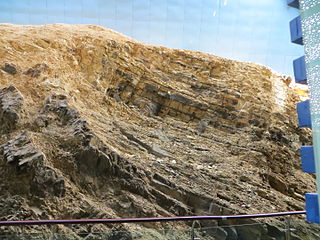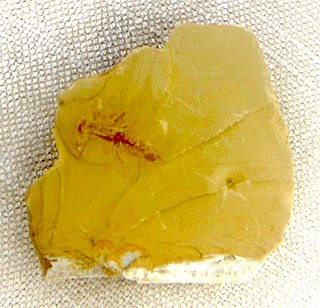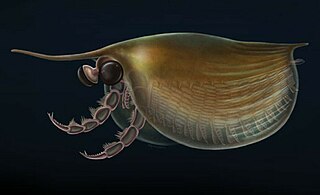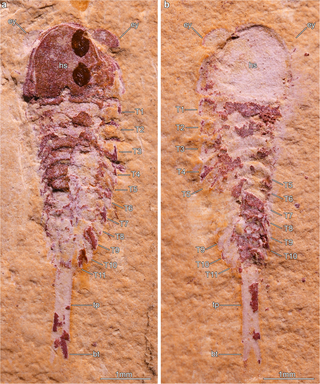
The Maotianshan Shales (帽天山页岩) are a series of Early Cambrian sedimentary deposits in the Chiungchussu Formation, famous for their Konservat Lagerstätten, deposits known for the exceptional preservation of fossilized organisms or traces. The Maotianshan Shales form one of some forty Cambrian fossil locations worldwide exhibiting exquisite preservation of rarely preserved, non-mineralized soft tissue, comparable to the fossils of the Burgess Shale of British Columbia, Canada. They take their name from Maotianshan Hill in Chengjiang County, Yunnan Province, China.

Leanchoilia is a megacheiran arthropod known from Cambrian deposits of the Burgess Shale in Canada and the Chengjiang biota of China.

Cindarella is genus of trilobite-like Cambrian arthropod known from the Chengjiang biota of China. It is classified in the stem group of trilobites (Artiopoda) in the clade Xandarellida, along with Phytophilaspis, Sinoburius, and Xandarella.

Clypecaris is genus of bivalved Cambrian arthropod known from the Chengjiang biota of Yunnan, China. The genus was initially described for the type species C. pteroidea by Hou, 1999. A second species C. serrata was described by Yang et al. in 2016. The species are primarily distinguished by the presence of a serrated edge on the front of the carapace of C. serrata. C. serrata is noted for the modification of an anterior pair of limbs into spined grasping appendages, indicating a predatory lifestyle. It is unknown whether a similar structure was present in C. pteroidea.Clypecaris is considered to likely be a member or a close relative of Hymenocarina, and is closely related to Perspicaris. As well as to Ercaicunia.
Combinivalvula is a genus of Cambrian arthropod known for being a member of the Chengjiang biota. It was described in 1987.
Comptaluta is an extinct genus of Cambrian bradoriid arthropod. The genus was erected by Armin Öpik, who described C. calcarata and C. profunda from the Ordian of Australia. Two further species have been described from the Chengjiang biota: C. kailiensis and C. inflata.
Diplopyge is genus of Cambrian arthropod known for being a member of the Chengjiang biota. It was described by Luo et al. in 1999.
Dongshanocaris is genus of Cambrian arthropod known for being a member of the Chengjiang biota, containing the single species D. foliiformis. It was described by Hou and Bergstrom in 1999. In 2013 Oxford University fellow David Legg described it as "too poorly preserved to verify their identity as a valid taxa".

Ercaicunia is genus of bivalved Cambrian arthropod from the Chengjiang biota of Yunnan, China. It contains a single species, E. multinodosa that was described by Luo et al. in 1999. The total length of the body ranges from 8 to 11 millimetres. The bivalved carapace covered about a third of the total body-length, and has up to six serrations on its forward edge. The head has a pair of large uniramous antennae, as well as a smaller pair of secondary antennae, as well as pair of mandibles and maxillae. The trunk has 16 pairs of biramous appendages. Specimens were CT scanned in 2019, which suggested it to be a stem-group crustacean. Other subsequent studies have recovered it as a member of Hymenocarina, which contains other bivalved Cambrian arthropods.

Haikoucaris is a genus of megacheiran arthropod that contains the single species Haikoucaris ercaiensis. It was discovered in the Cambrian Chengjiang biota of China.

Isoxys is a genus of extinct bivalved Cambrian arthropod; the various species of which are thought to have been freely swimming predators. It had a pair of large spherical eyes, and two large frontal appendages used to grasp prey.

Jianshania is genus of Cambrian arthropod known from the Chengjiang biota, containing the single species J. furfactus. It was described by Luo et al. in 1999. In 2020, a specimen originally assigned to the species was found to represent the separate fuxianhuiid taxon Xiaocaris pending revision of the type specimen.
Jiucunella is genus of Cambrian arthropod known from the Cambrian Chengjiang biota of China as well as Australia.

Kunmingella is genus of Cambrian bradoriid from the Chengjiang biota, containing the single species K. douvillei. Kunmingella had 12 appendages, including a pair of antennae as well pairs of biramous limbs, including four anterior pairs of appendages bearing double rows of endites on their endopods, and a posterior 5 with only a single row of endites, as well as two terminal pairs of uniramous limbs. Eggs have been found preserved attached to the posteriormost three pairs of biramous limbs, suggesting it engaged in brood care. Around 50–80 eggs, each around 150–180 μm across were attached in total.
Kunyangella is genus of Cambrian arthropods known for being a member of the Chengjiang biota, containing the single species K. cheni. It has a bivalved carapace and has tentatively been referred to the Bradoriida.
Liangshanella is a genus of Cambrian bradoriid known from the Chengjiang biota and Burgess Shale. 6263 specimens of Liangshanella are known from the Greater Phyllopod bed, where they comprise 11.9% of the community.

Occacaris oviformis is an extinct nektonic predatory arthropod from the Lower Cambrian Maotianshan shale Lagerstätte. It bears a superficial resemblance to the Cambrian arthropod, Canadaspis, though, was much smaller, and had a pair of "great appendages", with which it may have grasped prey. It was originally considered to belong to Megacheira, however it is questioned in later study.

Pectocaris is an extinct genus of bivalved arthropods from the Cambrian Maotianshan Shales, Yunnan Province of China. There are currently three known species within the genus.

Primicaris is genus of Cambrian arthropod from the Chengjiang biota of China and the Burgess Shale of Canada. It contains a single described species, P. larvaformis.
Pseudoiulia is a genus of Cambrian arthropod known from the Chengjiang Biota of Yunnan, China, containing the single species P. cambriensis. It is considered poorly known, but has been somewhat associated with other Chengjiang Biota fauna such as Dongshania folliformis and Pissinocaris subconigera. In 2013, Pseudoiulia was suggested to be a member of the family Kootenichelidae, alongside Kootenichela and Worthenella.











